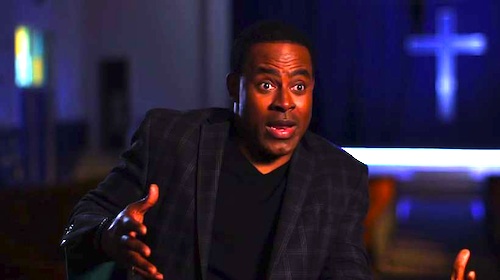
By Joe Bendel. When it was founded, Charleston, South Carolina was open to all Protestant denominations. It is also home to the oldest synagogue in the United States that is still in regular use. On the darker flip side, a shadowy satanic cult operated there not so very long ago. It was led by Maria and David Abascal’s late but not nearly deceased enough father Enos. Recently, she has had strange dreams and visions of the malevolent Enos Abascal. It is safe to say they had a complicated relationship, considering he encased a demon within her. Maria Abascal is mostly in control, but her relationship with the sulfurous Abigail is necessarily complex. Still, she does her best to keep Abigail and her more conventional inner demons at bay in South of Hell, which premieres binge-style with seven back-to-back episodes this Friday on WE tv.
Created by Eli Roth & Jason Blum and produced by Blumhouse Television, South is the show we never thought we would see on WE tv, but here it is. Of course, it has a woman protagonist—or rather two of them, played by Mena Suvari—which apparently counted for a lot. It also has Charleston, providing an unending supply of atmosphere.
Given the Jim Jones-ish notoriety of their father and the dangerous force sealed inside Maria, the Abascal siblings have led a rootless life on the margins of society. They mostly eke out a living as exorcists, but Maria is also a part-time fortune teller, while David is a full time junkie. Thanks to Abigail, they are quite effective when hired to expel evil spirits. Somehow, Abigail developed a taste for eating her own demonic kind. Maria is able to harness that power, but only just barely. Something sinister is afoot, but have perhaps found an unlikely ally in the Reverend Elijah Bledsoe.

One episode is hardly enough to support a conclusive judgement, but at least it leaves viewers wanting more. Logically, it is also helmed by Roth to hook in his fan base. He rather deftly plays up the sinister ambiance, suggesting much that will presumably followed-up on later. Suvari has had an up-and-down career, but she is really terrific as the disillusioned Abascal and the uber-vampy Abigail. She generates some major heat in her scenes with herself. Although, we only see him teasingly briefly, Bill “Old Hats” Irwin shows some serious villainous potential as old man Abascal. David Abascal and Rev. Bledsoe are yet to be fully developed, but Zachary Booth and Lamman Rucker seem well cast thus far.
If you live in Los Angeles, you can make this a demonic possession-themed Thanksgiving weekend by catching the ripping good Korean film The Priests at the CGV and binge watching South of Hell. Although it is too early to pass judgement on the entire series, the first episode is definitely grabby enough to make you want to see the second, which is a tad frustrating when it is all you have. Definitely worth trying (and hopefully worth finishing), all seven episodes of South of Hell premiere tomorrow (11/27) on WE tv.
Posted on November 27th, 2015 at 1:50pm.






